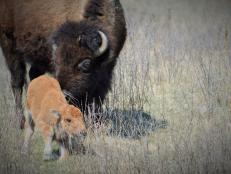8 Things We Know About the Mysterious Yeti

Josh Gates has a history with yetis: Over the past 10 years, he has uncovered at least two pieces of possible evidence of the elusive animal, only intensifying his deep fascination with the legend behind it. Now, in a special four-part series for Travel Channel, Josh and his Expedition Unknown team are reviving his long-time hunt for clues of the yeti’s existence by trekking through the Himalayas, and even making his way to Mt. Everest Base Camp, in Expedition Unknown: Hunt for the Yeti.
There have been plenty of tall tales and hoaxes throughout the past century, but what conclusive evidence is there of the yeti’s existence? Ahead of the Expedition Unknown premiere on Oct. 5, here’s a quick rundown of what we know about the mysterious yeti, plus a sneak peek at what we’ll learn in Hunt for the Yeti.
He’s a Bipedal Hominid
“Bipedal” refers to an animal that walks on two legs, and “hominid” refers to the family of “Great Apes,” primates that includes gorillas, orangutans, humans and their ancestors and relatives (like the Neanderthal). The yeti is in this same class with other mythical creatures like Big Foot or Australia’s Yowie.
Encounters are Most Common in Nepal and Bhutan
Though there have been alleged encounters in India and Tibet, most of them come from these high altitude nations of the Himalayas. Many people believe he lives in caves, where one alleged sighting was caught on camera by scientists from the Yeti Project of Japan, whom Josh interviews in Hunt for the Yeti.

The Yeti is Not White
Despite the winterish creature we saw in the 1964 Rudolph the Red-Nosed Reindeer animated special, yeti sightings have consistently identified the creature as having reddish brown fur. The idea of a white coat was conjured up by western culture, mostly a poetic embellishment of writers over the years.
Urban Legend vs. Elusive Creature
Researchers like Adam Davies claim to have found many credible eyewitnesses who have spotted the yeti in the Himalayas, but sightings have been reported around the world. The majority of these reports have turned out to be hoaxes, including a recent sighting in Spain that turned out to be a marketing stunt by the ski resort for a sunglasses company.
Vladimir Putin Claims to Have Seen a Yeti While on Vacation
The Russian president said in April 2016 that he actually saw a family of yetis while on a helicopter trip over remote Siberian mountains. The Kremlin press service announced they would be releasing photos of the sighting, but have yet to do so.
Pop Culture Loves the Yeti
Often depicted as a 6-foot-tall white furball, the yeti -- which is often confused with the “abominable snowman” -- has popped up in quite a few movies and shows over the past century. He is an unforgettable obstacle in the original Rudolph the Red-Nosed Reindeer (1964), a subject of much interest to explorers in Doctor Who, a Pokemon character named Abomasnow and an unusually adorable character named Bumble in Monsters, Inc. And those are just the tip of the iceberg. (Ha.)
Only 3 DNA Samples of the Purported Yeti Have Been Claimed
Despite scientists collecting 58 hair samples of alleged cryptozoological creatures -- yetis, Big Foot, Yowie -- only three of them were claimed to be from the yeti. And of those? None were anomalous, or proved to be belonging exclusively to a yeti.
There are Very Few Other Conclusive Traces of the Yeti
An expedition team in the 1950s claimed to have discovered the scalp of a yeti, which is now on display at the Khumjung Monastery in Nepal. And almost 10 years ago, Josh Gates had his first encounter with yeti evidence, discovering a five-digit footprint in the Everest region of Nepal. In 2009, he also found hairs that were later determined to contain an unknown DNA sequence.

Will Josh Gates discover even more evidence of the yeti on his latest expedition? Find out in the premiere of the four-part special Expedition Unknown: Hunt for the Yeti, airing October 5 at 9|8c on Travel Channel.


